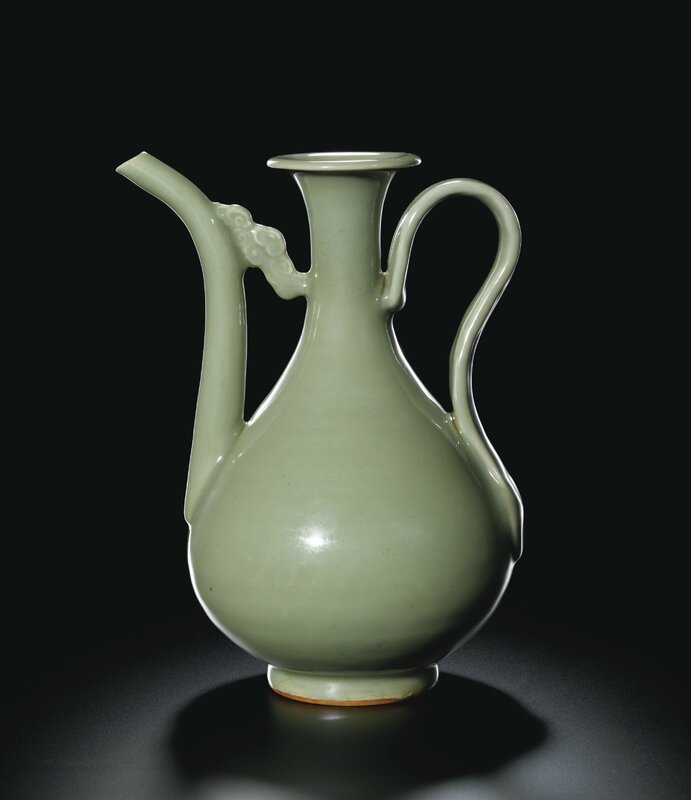An exceptional Longquan celadon ewer, Ming dynasty, early 15th century
Lot 3128. An exceptional Longquan celadon ewer, Ming dynasty, early 15th century; 28.8 cm., 11 3/8 in. Estimate 3,000,000 — 4,000,000 HKD (293,574 — 391,432 EUR). Lot sold 3,380,000 HKD (330,760 EUR). Photo: Sotheby's
the well balanced pear-shaped body rising from a straight foot to a slender neck and an everted mouth rim, set on one side with a tall curved tubular spout joined to the neck by a moulded cloud-shaped strut, opposite an arched strap handle, all beneath a glossy and unctuous celadon glaze pooling below the belly and near the foot, the glaze of ideal sage-green tone, the footrim left unglazed and fired to a bright orange with areas revealing the pale grey body beneath.
Provenance: An old Japanese collection.
Note: The elegance of the present ewer is captured in its long slender neck, the gentle curves of which are echoed in the lines of the body, spout and handle. Longquan ewers of this yuhuchun ping form are rare although a closely related example in the Zhejiang Provincial Museum is published in Celadons from Longquan Kilns, Taipei, 1998, pl. 251; and another from the Manno Art Museum, Osaka, was sold at Christie's Hong Kong, 28th October 2002, lot 558. Fragments of a ewer of this type, excavated from Dayao Fengdongyan site at the Longquan kiln in Zhejiang province, and in the Longquan Celadon Museum, Longquan, was included in the exhibition The Flower of Green Jade – Longquan Celadon of the Ming Dynasty. Recent Archaeological Findings of the Dayao Fengdongyan Kiln Site, The Museum of Oriental Ceramics, Osaka, Osaka, 2011.
Originally inspired by Persian metal wares, the form was probably standardised by the court in the early Ming dynasty where the slender proportions became heavier, the rim galleried and the body often carved with designs inspired by blue-and-white porcelain produced in the Imperial kilns at Jingdezhen; for example see three Longquan ewers illustrated in Regina Krahl,Chinese Ceramics in the Topkapi Saray Museum, Istanbul, vol. 1, London, 1986, pls. 225-227.
The form of this vase is also known from slightly smaller Longquan celadon vases attributed to the Yuan period, such one with a tobi seiji glaze, from the Ataka collection and now in the Museum of Oriental Ceramics, included in the Exhibition of Oriental Ceramics, Museum of Oriental Ceramics, Osaka, 1982, cat. no. 23; and another with a plain celadon glaze, from the J.M. Hu collection sold at Christie's New York, 15th September 2009, lot 342. For a silver vase dated to 1333, from the storage site at Kongzimiao Shrine, Hefei in Anhui province, in the Anhui Provincial Museum, Hefei, see one illustrated in Sekai bijutsudai zenshei. Yuan, vol. 7, Tokyo, 1999, pl. 204.
Sotheby's. Fine Chinese Ceramics & Works of Art, Hong Kong, 04 Apr 2012

/https%3A%2F%2Fprofilepics.canalblog.com%2Fprofilepics%2F1%2F0%2F100183.jpg)
/https%3A%2F%2Fstorage.canalblog.com%2F03%2F02%2F119589%2F96711876_o.jpg)
/https%3A%2F%2Fstorage.canalblog.com%2F11%2F31%2F119589%2F94773502_o.jpg)
/https%3A%2F%2Fstorage.canalblog.com%2F20%2F83%2F119589%2F94772815_o.jpg)
/https%3A%2F%2Fstorage.canalblog.com%2F26%2F72%2F119589%2F75604929_o.jpg)
/https%3A%2F%2Fstorage.canalblog.com%2F59%2F60%2F119589%2F26458628_o.jpg)




/http%3A%2F%2Fstorage.canalblog.com%2F97%2F49%2F119589%2F129856334_o.jpg)
/http%3A%2F%2Fstorage.canalblog.com%2F25%2F08%2F119589%2F129521423_o.jpg)
/http%3A%2F%2Fstorage.canalblog.com%2F43%2F43%2F119589%2F129237428_o.jpg)
/http%3A%2F%2Fstorage.canalblog.com%2F73%2F38%2F119589%2F128525398_o.jpg)